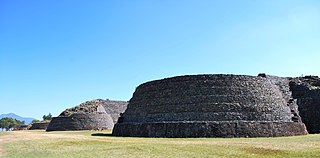Related Research Articles

The Purépecha are a group of Indigenous people centered in the northwestern region of Michoacán, Mexico, mainly in the area of the cities of Cherán and Pátzcuaro.

Tzintzuntzan was the ceremonial center of the pre-Columbian Purépecha capital of the same name. The name comes from the Purépecha word Ts’intsuntsani, which means "place of hummingbirds." The site includes at least 1,000 archaeological features in an area that is at least 1,075 hectares.
The Purépecha are an indigenous people of the Mexican state of Michoacán.

Michoacán, formally Michoacán de Ocampo, officially the Estado Libre y Soberano de Michoacán de Ocampo, is one of the 31 states which, together with Mexico City, comprise the Federal Entities of Mexico. The state is divided into 113 municipalities and its capital city is Morelia. The city was named after José María Morelos, a native of the city and one of the main heroes of the Mexican War of Independence.

Zamora de Hidalgo(Spanish pronunciation: [saˈmoɾa de i'dalɢo]) is a city in the Mexican state of Michoacán. The 2010 census population was 141,627. making it the third largest city in the state. The city is the municipal seat of Zamora Municipality, which has an area of 330.97 km² and includes many other smaller communities, the largest of which is Ario de Rayón. The municipality's population is around 186,102, which makes it the second most populous urban area in the state.

Princess Eréndira of the Purépecha was the princess of the Purépecha from c. 1503–1529.
The Tarascan Plateau, also Purépecha Plateau, is a plateau and region in the Mexican state of Michoacán, in Southwestern Mexico.

The Purépecha Empire, also known by the term Iréchikwa, was a polity in pre-Columbian Mexico. Its territory roughly covered the geographic area of the present-day Mexican state of Michoacán, as well as parts of Guanajuato, Guerrero, and Jalisco. At the time of the Spanish conquest, it was the second-largest state in Mesoamerica. The state is also known as the Tarascan Empire, an exonym often considered pejorative by the Purépecha people.

Purépecha, often called Tarascan, a term coined by Spanish colonizers which can be seen as pejorative, is a language isolate or small language family that is spoken by some 140,000 Purépecha in the highlands of Michoacán, Mexico.

Tzimtzincha-Tangaxuan II was the last cazonci (monarch) of the Purépecha Empire, from C.E.1520–1530. He was baptized Francisco when his realm made a peace treaty with Hernán Cortés. He was executed by burning by Nuño Beltrán de Guzmán on February 14, 1530.

Tzintzuntzan is a town in Tzintzuntzan Municipality located in the north of Michoacán state, 53 km from the capital of Morelia and 17.5 km from Pátzcuaro, located on the northeast shore of Lake Pátzcuaro. It is best known as the former capital of the Tarascan state until it was conquered by the Spanish in the 1520s. Today, Tzintzuntzan is a small town with two major attractions, the archeological site of Tzintzuntzan and the former monastery complex of San Francisco. The municipality contains another important archeological site called Ihuatzio. It is also notable for its festivals, which include the Festival of Señor del Rescate, Day of the Dead celebrations and a cultural event related to New Year's.

Huandacareo is an archaeological zone located about 60 kilometers north of the city of Morelia, in the state of Michoacán.

Ihuatzio is an archeological site in Michoacán state, Mexico. It is at the southern slopes of Cerro Tariaqueri, just north of the Ihuatzio town, in the Tzintzuntzan municipality.
Pirekua (Purépecha) is a song form of the Purépecha. The singer of a pirekua, a pirériecha, may be male or female, solo or accompanied, and pirekua may be performed instrumentally. Pirériechas act as social mediators and "express sentiments and communicate events of importance to the Purépecha communities."
Paul William Friedrich was an American anthropologist, linguist, poet, and Professor of Social Thought at the University of Chicago. He studied at Harvard with Roman Jakobson, and received his Ph.D. from Yale under the supervision of Sidney Mintz. He specialized in Slavic languages and literature, and in the ethnographic and linguistic study of the Purépecha people of Western Mexico, as well as in the role of poetics and aesthetics in creating linguistic and discursive patterns. Among his best known works were Agrarian Revolt in a Mexican Village, The Princes of Naranja: An Essay in Anthrohistorical Method (1987), both ethnographic works describing local politics in a small community in the Mexican state of Michoacan. And in linguistics his works The Tarascan Suffixes of Locative Space: Meaning and Morphotactics (1971) and A Phonology of Tarascan (1973) were among the most detailed as well as earliest modern linguistic of the Purépecha language. In 2005, his former students honored him with a festschrift titled Language, Culture and the Individual: A Tribute to Paul Friedrich. In 2007 Yale University awarded Friedrich with the Wilbur Cross Medal. A prolific poet, he also published seven collections of poems, some of them focusing on the haiku form. He is the father of filmmaker Su Friedrich.

Zinapécuaro is a municipality in the Mexican state of Michoacán, located 50 kilometres (31 mi) northeast of the state capital Morelia.

Indaparapeo is a municipality in the Mexican state of Michoacán, located approximately 25 kilometres (16 mi) east of the state capital of Morelia.

Huaniqueo is a municipality in the Mexican state of Michoacán, located approximately 40 kilometres (25 mi) northwest of the state capital of Morelia.

Nahuatzen is a municipality in the Mexican state of Michoacán, located approximately 75 kilometres (47 mi) west of the state capital of Morelia.

Zinapécuaro de Figueroa is a town and the seat of the municipality of Zinapécuaro, in the central Mexican state of Michoacán.